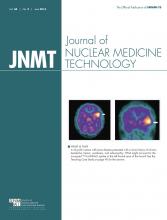Abstract
The ability to assess tumor biology is a benefit of molecular imaging with 18F-FDG PET/CT, which performs better than anatomic imaging in evaluating malignancies. We present an unusual case of fatal dermatofibrosarcoma protuberans, a usually indolent entity for which high-grade 18F-FDG uptake was predictive of an aggressive clinical course unabated by tyrosine kinase inhibitor imatinib mesylate, to which the patient showed a poor response.
Uptake of 18F-FDG is a useful index of tumor biology and heterogeneity in several types of malignancy (1–3). Although the potential of this application of 18F-FDG in PET/CT imaging has been postulated and published in multiple studies, its routine use in clinics continues to evolve. Here, we discuss a case in which a malignancy that typically is relatively indolent showed high 18F-FDG uptake, which was subsequently found to be commensurate with increased metastatic potential and an aggressive disease course.
CASE REPORT
The patient was a 63-y-old man with left lumbar dermatofibrosarcoma protuberans, for which he had undergone a second surgery about 1 y previously because of local recurrence. In view of the recurrence, he had received local radiotherapy. Recently, he had presented with a left axillary mass for which 18F-FDG PET/CT was performed to assess his whole-body disease status (Fig. 1). Multiple 18F-FDG–avid well-defined lesions were seen bilaterally in the lung parenchyma (the largest, in the left lower lobe, measuring 4.2 × 2.8 cm and having an SUVmax of 14.38). Also noted was a large, well-defined soft-tissue mass in the left axilla (4.9 × 4.1 cm; SUVmax, 13.31), a subcutaneous nodule in the right anterior abdomen (2 × 2 cm; SUVmax, 5.82), and a sclerotic lesion in the right iliac bone (SUVmax, 7.40), all of which showed high 18F-FDG uptake. The patient was started on imatinib mesylate tyrosine, a kinase inhibitor approved for unresectable or metastatic dermatofibrosarcoma protuberans. Early PET/CT monitoring of the treatment was planned, but the patient’s condition deteriorated rapidly and he died about 1 mo after beginning the therapy.
Maximum-intensity-projection (top), transaxial (middle), and coronal (bottom) 18F-FDG PET/CT images showing high uptake in lung, soft-tissue, subcutaneous, and iliac lesions.
DISCUSSION
Dermatofibrosarcoma protuberans is usually a slow-growing tumor that behaves in a benign fashion. Although it can recur locally, it rarely metastasizes (incidence < 5%) and typically has a relatively good prognosis (4,5). Here, we have illustrated the imaging features of 18F-FDG PET/CT in an unusual case of dermatofibrosarcoma protuberans in which high-grade 18F-FDG uptake correctly predicted an aggressive course. The ability to depict tumor biology is a benefit of 18F-FDG PET/CT imaging (1–3), which performs better than anatomic imaging in evaluating malignancies. There have been a couple of reports (6,7) on the role of 18F-FDG PET/CT in detecting distant metastasis of dermatofibrosarcoma protuberans, highlighting the fact that metastasis of this entity, though rare, is possible. Two reports (8,9) have also illustrated a possible role for 18F-FDG PET/CT in monitoring the response of dermatofibrosarcoma protuberans to treatment with imatinib mesylate. However, to our knowledge there has been no specific literature on its role in predicting aggressive biology in individuals showing high uptake at the diseased sites.
CONCLUSION
As illustrated by this case, the ability to predict tumor biology is an important advantage of 18F-FDG PET/CT imaging that has the potential to form the basis of personalized medicine in oncology.
DISCLOSURE
No potential conflict of interest relevant to this article was reported.
Footnotes
Published online Sep. 3, 2015.
REFERENCES
- Received for publication July 2, 2015.
- Accepted for publication July 24, 2015.








